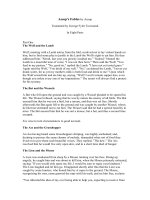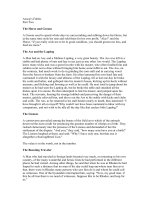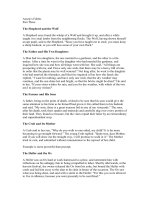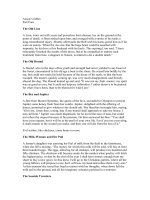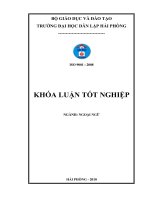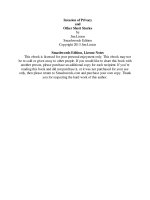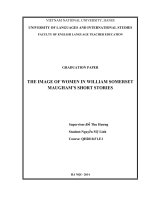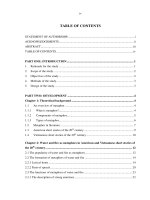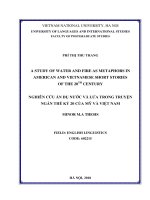Left dislocation and right dislocation in english versus vietnamese equivalents in some english and vietnamese short stories from 1990 until now
Bạn đang xem bản rút gọn của tài liệu. Xem và tải ngay bản đầy đủ của tài liệu tại đây (774.96 KB, 63 trang )
VIETNAM NATIONAL UNIVERSITY, HANOI
UNIVERSITY OF FOREIGN LANGUAGES AND INTERNATIONAL STUDIES
FACULTY OF POST- GRADUATE STUDIES
NGUYỄN THỊ NGỌC MAI
LEFT DISLOCATION AND RIGHT DISLOCATION IN ENGLISH
VERSUS VIETNAMESE EQUIVALENTS IN SOME ENGLISH AND
VIETNAMESE SHORT STORIES FROM 1990 UNTIL NOW
Cấu trúc dịch chuyển thông tin sang trái và dịch chuyển thông tin sang
phải trong tiếng Anh và tương đương trong tiếng Việt trong một số
truyện ngắn tiếng Anh và tiếng Việt từ năm 1990 đến nay
MA. MINOR THESIS
Major: English Linguistics
Code : 60220201
HÀ NỘI – 2016
VIETNAM NATIONAL UNIVERSITY, HANOI
UNIVERSITY OF FOREIGN LANGUAGES AND INTERNATIONAL STUDIES
FACULTY OF POST- GRADUATE STUDIES
NGUYỄN THỊ NGỌC MAI
LEFT DISLOCATION AND RIGHT DISLOCATION IN ENGLISH
VERSUS VIETNAMESE EQUIVALENTS IN SOME ENGLISH AND
VIETNAMESE SHORT STORIES FROM 1990 UNTIL NOW
Cấu trúc dịch chuyển thông tin sang trái và dịch chuyển thông tin sang
phải trong tiếng Anh và tương đương trong tiếng Việt trong một số
truyện ngắn tiếng Anh và tiếng Việt từ năm 1990 đến nay
MA. MINOR THESIS
Major: English Linguistics
Code : 60220201
Supervisor: Dr. Huỳnh Anh Tuấn
HÀ NỘI – 2016
i
DECLARATION
I certify that this minor thesis entitled “Left dislocation and right dislocation in
English versus Vietnamese equivalents in some English and Vietnamese short
stories from 1990 until now”is the result of my own research and all the
materials used in this study has been identified and acknowledged. This M.A
thesis has not been submitted for any degree to any other universities or
institutions.
Ha Noi, 2016
Nguyen Thi Ngoc Mai
i
ii
ACKNOWLEDGEMENTS
My minor thesis has been completed thanks to the assisstance and guidance of
my teachers, my family as well as my friends.
First of all, I would like to express my most sincere gratitude to my supervisor,
Dr. Huynh Anh Tuan for his enthusiastic assistance, academic guidance, good
suggestions and critical comments on my study, without which the work would
not have been completed.
Secondly, I am greatly indebted to my lecturers in the faculty of post- graduate
studies for their useful lectures and contribution to my study.
Last but not least, I would like to acknowledge the considerate support and
indispensable assistance of my family, my friends and my colleagues while the
work was being done.
One more thing I would like to say is that in spite of all the efforts I have made
and the advice and assistance I have received, I am sure my minor thesis is far
from perfect. Therefore, it is my responsibility for any inadequacies and
shortcomings that arise in my minor thesis.
Hanoi, October 2016
Nguyen Thi Ngoc Mai
ii
iii
ABSTRACT
This research is carried out to investigate the similarities and differences in the
use of Left dislocation and Right dislocation in English and Vietnamese short
stories. The analytical data is collected from ten English and ten Vietnamese
short stories from 1990 until now. In the research, Left dislocation and Right
dislocation in English is compared and contrasted with Vietnamese equivalents
in terms of their structure and function. The result of the research shows that
there are similarities and differences in the use of these constructions in English
and Vietnamese short stories. The most prominent similarity in the use of LD
and RD in English and Vietnamese short stories is that in terms of structure,
these constructions can be realized by a Noun phrase moved leftward or
rightward is coreferential with a resumptive pronoun in the same sentence. And
the most significant difference is that LD realized in English short stories can
perform the function of contrasting while Vietnamese LD does not. On the other
hand, Vietnamese RD can function to focus whereas English RD does not.
iii
iv
TABLE OF CONTENTS
i
Declaration ........................................................................................................
i
ii ii
Acknowledgments ............................................................................................
iii iii
Abstract ...........................................................................................................
iv iv
Table of contents .............................................................................................
List of abbreviations……………………………..………………… viii
ix
List of figures……………………………………………………….
PART A: INTRODUCTION
1. Rationale ........................................................................................................
1 1
2. Aims of the study ...........................................................................................
2 2
3.Research questions…………………………………………………
2
4. Scope of the study..........................................................................................
2 2
5. Method of the study .......................................................................................
3 3
6. Design of the study ........................................................................................
3 3
PART B: DEVELOPMENT
4
CHAPTER 1. LITERATURE REVIEW………………………..
4
1.1 Review of previous studies……………………………………..
5
1.2. Canonical and non-canonical structures……………………..
6
1.3. Left dislocation in English……………………………………..
1.3.1. Definition……………………………………………………...
6
1.3.2. Realizations……………….…………………………………..
6
1.3.3. Structural features..……………………………………….…..
8
1.3.4. Functional features..…………………………………………..
9
1.4. Right dislocation………………………………………….…… 11
1.4.1. Definition……………………………………………………... 11
1.4.2. Realizations…………………………………………………… 11
1.4.2.1. Right dislocation and post- posing………….……………… 11
1.4.2.2. Right dislocation and afterthought…………………………. 12
1.4.3. Structural features…………………………………………….
13
1.4.4. Functional feature…………………………………………….. 14
1.5. English vs Vietnamese sentence structures and sentence
elements…………………………………………………………….. 16
iv
v
1.6. Left dislocation and right dislocation in
Vietnamese………………………………………………………….
1.6.1. Left dislocation in Vietnamese………………………………..
1.6. 2. Right Dislocation in Vietnamese……………………………..
CHAPTER 2: METHODOLOGY………………………………...
2. 1. Research questions………..…………………………………..
2. 2. Research methods……………………………………………..
2. 3. Selection of samples…………………………………………..
2. 4. Data analysis…………………………………………………..
CHAPTER 3: DATA ANALYSIS AND DISCUSSIONS………..
3.1. Data analysis……………………………………………………
3.1.1. The percentages of LD and RD in English and Vietnamese
short stories…………………………………………………………..
3.1.1.1. The percentages of LD and RD in English short stories……
3.1.1.2.The percentages of LD and RD in Vietnamese short stories...
3.1.1.3. The percentages of LD and RD in English and Vietnamese
short stories…………………………………………………………..
3.1.2. The Structures and functions of LD in English and
Vietnamese short stories..…………………………………………....
3.1.2.1. The Structures of LD in English and Vietnamese short
Stories………………………………………………………………..
3.1.2.2. The functions of LD in English and Vietnamese short
Stories………………………………………………………………..
3.1.3. The Structures and functions of RD in English and
Vietnamese short stories……………………………………………..
3.1.3.1. The Structures of RD in English and Vietnamese short
stories..................................................................................................
3.1.3.2. The functions of RD in English and Vietnamese short
stories………………………………………………………………...
3.2. Discussions……………………………………………………...
3.2.1. Left dislocation in English and Vietnamese short stories.........
3.2.1.1. Similarities…………………………………………………..
v
17
17
18
20
20
20
21
22
23
23
23
23
24
25
26
26
27
31
31
31
35
35
35
vi
3.2.1.2. Differences………………………………………………….. 36
3.2.2. Right dislocation in English and Vietnamese short stories…... 36
3.2.2.1. Similarities………………………………………………….. 36
3.2.2.2. Differences………………………………………………….. 37
38
PART C: CONCLUSION
1. Concluding remarks…...………………………………………... 38
1.1. Left dislocation in English and Vietnamese short stories………. 38
1.1.1. Similarities……………………………………………………. 38
1.1.2. Differences……………………………………………………. 38
1.2. Right dislocation in English and Vietnamese short stories..…… 39
1.2.1. Similarities………………………………………………….… 39
1.2.2. Differencies…………………………………………………... 39
1.3. The frequency of using LD and RD in English and Vietnamese
short stories………………………………………………………….. 39
2. Limitations of the study…………………………………………. 40
3. Pedagogical implications………………………………………... 40
4. Suggestions for further study…………………………………... 40
References………………………………………….………..……… 41
I
Appendix I…………………………………………………..………
Appendix II………………………………………………………… VI
Appendix III……………………………………………………...… VIII
X
Appendix IV………………………………………………………...
vi
vii
LIST OF ABBREVIATIONS
LD: Left Dislocation
RD: Right Dislocation
NP: Noun Phrase
vii
viii
LIST OF FIGURES IN THE STUDY
Figure
Title
Page
1
Frequency of LD and RD in English short stories
24
2
Frequency of LD and RD in Vietnamese short stories
25
Frequency distribution of LD and RD in English and
3
26
Vietnamese short stories
Distribution of LD performing the functions of Topicalizing,
4
Focusing and Contrasting in English short stories.
27
Distribution of LD performing the functions of Topicalizing
5
and Focusing in Vietnamese short stories.
29
Distribution of LD performing the functions of Topicalizing,
6
Focusing and Contrasting in English and Vietnamese short
30
stories
Distribution of RD performing the functions of Identifying
7
the referent, Reintroducing the topic and Adding attributive
32
meaning in English short stories
Distribution of RD performing the functions of Identifying
8
the referent, Reintroducing the topic, Adding attributive
33
meaning and Focusing in Vietnamese short stories
Distribution of RD performing the functions of Identifying
9
the referent, Reintroducing, Adding attributive meaning and
focusing in English and Vietnamese short stories.
viii
34
PART A: INTRODUCTION
1. Rationale
One of the key questions to be solved by reader/ listener when confronted with a
sentence is to determine ―who did what to whom‖. To this end, the reader/listener must
be able to unambiguously identify the different constituents of a sentence in order to
assign thematic and syntactic roles. Interestingly, different languages draw on different
sources of information for role assignment. Mac Whinney et al (1984) have shown that
while Italian subjects used agreement information as the most important cue, English
subjects rely primarily on word order.
In linguistics, word order is to the study of the order of the syntactic constituents of a
language, and each language may employ a different order. The connection between
word orders in different languages is of interest to linguistics. They found that among
natural languages with a word order preference, SVO is the second most common
order by number of known languages, after SOV, including English.
However, English speakers are provided with a variety of non canonical syntactic
means for expressing a given proposition. ―Although these non canonical-word-order
utterances may be truth-conditionally equivalent to the corresponding canonical
variant, they differ in their relationship to the discourse context‖. (Birner, 1994)
The interaction between structures and functions has been an interesting and inspiring
topic for many past scholars, who have already done a number of researches on it.
They have studied, for instance, the functions of different moods, different
interrogative forms and so on and so forth. However, studies on dislocated structures,
which we refer to as non-canonical constructions here, are relative few. These noncanonical constructions are, however, quite common found in colloquial usages as they
seem to serve a wide range of functions. The present study is thus interested in
systematically studying the structural and functional features of two specific non1
canonical constructions, namely left dislocation (LD) and right dislocation (RD) in
English and Vietnamese.
2. Aims of the study
The study aims at:
+ Investigating the use of Left dislocation and Right dislocation in English and in
Vietnamese short stories in terms of their structure and function.
+ Working out the similarities and differences in the use of these two constructions as
revealed in some English and Vietnamese short stories in terms of their structure and
function.
3. Research questions
In order to realize the aims, the study purports to answer the following research
questions:
1. How are the structure and function of Left dislocation and Right dislocation realized
in English and in Vietnamese short stories?
2. What are the similarities and differences in the use of Left dislocation and Right
dislocation in English and Vietnamese short stories in terms of their structure and
function?
4. Scope of the study
The study is carried out and concerned especially with the two non-canonical
constructions: LD and RD. The study focuses on the exploration of two following
aspects of these constructions: the structural features and pragmatic functions. Because
of the limitation of a minor thesis the study just collects data and investigates ten English
short stories and tenVietnamese ones from 1990 until now to analyze and find out the
similarities and differences between these constructions in English and Vietnamese
equivalents.
2
5. Method of the study
In order to achieve the aims of the study, both quantitative and qualitative approach are
used.
In using qualitative method, the author sets up criteria for selecting LD and RD in short
stories and deciding which certain function the dislocation construction performs.
In using quantitative method, the frequencies of the use of left dislocations and right
dislocations in English and Vietnamese short stories to perform a certain function is
shown.
Finally, a contrastive analysis is carried out in order to find out the similarities and
differences on the use of LD and RD in English and Vietnamese short stories in terms
of their structure and function.
6. Design of the study
The paper is divided into three main parts: introduction, development, and conclusion.
Part A: Introduction, briefly introduces the rationale of the study, the aims and
objectives of the study, research questions, scope of the study, the method of the study,
and the significance.
Part B: Development, is the focus of the study, consists of 3 chapters:
Chapter one , Literature Review deals with the literature relevant to the topic
Chapter two, Left dislocation and Right dislocation in English and Vietnamese,
provides with the structural and functional features of these constructions.
Chapter three, Methodology, presents the subjects, the research questions, study
methods and the procedures of data collection and data analysis.
Chapter four, Findings and discussion, analyses and discusses the findings which were
gained from the data collected.
Part C: Conclusion, concerns with the summaries of main points, the limitation, the
implication and some suggestions for further study.
3
PART B: DEVELOPMENT
CHAPTER 1: LITERATURE REVIEW
Before carrying out the study, it is very crucial for the author to establish the
theoretical framework so that readers have good background knowledge of the relevant
issues. This will shed light for the nature of this study. In this chapter, the previous
studies will be reviewed to offer a panorama of what is going to be investigated. After
that, some conceptions or notions are given to introduce the reader the requisite
background for understanding the remainder of the theoretical model, including:
review of previous studies, canonical and non-canonical constructions, Left
Dislocation, Right Dislocation, the comparison between English and Vietnamese
Dislocation constructions in terms of their structure and function.
1.1. Review of previous studies related to the research area
There have been a fair number of researches that have been done preliminarily on LD
and RD. Among the pre-eminent authors who discuss LD in great details are
Lambrecht (1984, 2001); Prince (1981, 1992, 1998); Ward and Birner (2001); and
Tizón-Couto (2012).
Discussions about RD can be found in Rodman (1998);
Lambrecht (1984); Ward and Birner (2001); Grosz and Ziv (1998). And The research
on LD and RD in English carried out by European scholars up to now can be
considered thorough and deep.
In Vietnamese, there have been a few studies on the dislocation constructions which
can be found in Nguyen Kim Than (1997); Diep Quang Ban (2004); Nguyen Huu
Quynh (2001); Nguyen Lan Trung (2009); Nguyen Thi Thanh Huyen (2011). Although
there are a lot of researches related to other noncanonical constructions in Vietnamese
in comparison with English, such as passive voice (Thuy, 2006), Fronting (Anh, 2011),
Information packaging constructions i.e. Inversion, Cleft, Existential, Extraposition
(Nhat, 2013); a contrastive study of dislocations between English and Vietnamese has
4
not been carried out yet. As a result, the author would like to carry out a study on this
matter to fill this gap as well as provide language learners an overview of the
differences and similarities in the use of left and right dislocations in English and
Vietnamese short stories in term of their structure and function.
1.2. Canonical and Non-canonical structures
Halliday and Matthiessen (2004) states that sentential subject can be classified into
three types in accordance with its function: grammatical, psychological and logical.
The subject is which followed by a predicate in a subject –predicate structure is called
grammatical one. Psychological subject is understood as the first thing appearing in the
mind of the speaker in producing a sentence. Logical subject refers to the doer of the
action.
Accordingly, Constructions in English beginning with a grammatical subject are
canonical constructions (Halliday & Mathiessen, 2004; Quirk et al, 1985). Quirk et al
(1985:721) classified the canonical structures into seven types: SV, SVC, SVO, SVA,
SVOO, SVOC, and SVOA.
SV
The boy is running.
SVC
Your mother seems angry.
SVO
My brother bought a house.
SVA
My house is on the third floor.
SVOO
She gave me an apple.
SVOC
John‘s son made him sad.
SVOA
He kicked the ball into the goal.
On the other hand, Non canonical constructions are those which do not begin with a
grammatical subject except for conversing.
Eg: John and his two siblings benefited from the farm.
The farm benefited John and his two siblings.
In the above examples, both sentences with convertible orders are acceptable.
5
Therefore, both of them are viewed as bearing a non-canonical pattern even though
they begin with a grammatical subject.
Like canonical, there are 7 non-canonical constructions (Ward & Birner, 2001; Quirk
et al, 1985): Fronting, Left-dislocation, Argument reversal (inversion & passivization),
Cleft structure, Post-posing (existential there- and presentational there-sentences),
Right-dislocation and Conversing.
In this thesis, left dislocation and right dislocation are considered as the focus for
investigating.
1.3. Left dislocation in English
1.3.1. Definition
LD has been paid a lot of attention from the researchers for a long time. It was first
identified by Ross in 1967 as a syntactic form in which some noun phrases (NP) appear
in initial pre-clausal position, coreferential with a personal pronoun occurring
somewhere in the clause, as shown in the following examples, the dislocated elements
and pronouns are bold.
a. The man my father works with in Bostoni, he's going to tell the police that the
traffic expert has set that traffic light on the corner of Murk Street far too low. (Ross
1967:6.128a)
b. My father, he’s Armenian, and my mother, she's Greek. ( Ross 1967:6.129)
c. My wife, somebody stole her handbag last night. (Ross 1967:6.137)
According to Lambrecht (2001), left dislocation is defined as ―a sentence structure in
which a referential constituent which could function as an argument or adjunct within
a predicate-argument structure occurs instead outside the boundaries of the clause
containing the predicate to its left”.
1.3.2. Realizations
LD is often mistaken as pre-posing due to the fact that an item is preposed i.e. moved
leftwards in the construction:
6
E.g. The cheese they made there, they sold most of it to the miners (Brown,
1983:321).
The canonically constructed sentence would have been:
They sold most of the cheese they made there to the miners.
However, the differences related to structure and functions of the two constructions are
indicated in the studies conducted by Ward and Birner (2001), Erteschic-Shir (2007) ,
and Prince (1997) pointed out as follows.
Regarding to the structure, the canonical position of the item is left unoccupied in preposing whereas a resumptive coreferential pronominal element appears in the marked
constituent‘s canonical position in left-dislocation. In the above example, co-referential
with the sentence-initial item the cheese they made there is the direct object pronoun it.
What‘s more, left dislocation is also different from pre-posing in terms of function.
While the preposed constituent ―represents information standing in a contextual
relationship with information either discourse old or evoked or inferable based on prior
discourse‖, the left-dislocated item ―introduces discourse-new (or maybe hearernew)
information‖. In the above example, ‗the cheese they made there‘ has never before
appeared in the discourse.
Regarding to the intonation, Douglas (2004) stated that left dislocation has a falling
intonation in the main clause whereas topicalization has a slight rise at the end of it.
The level of intonation of left dislocation is illustrated in the following examples:
The Saturns, you can get air bags in them
And heavy metal, it‘s noisy.
Well, my car, it‘s an eighty six.
7
Left dislocation (Douglas, 2004)
1.3.3. Structural features
LD is generally identified by the presence of a referential constituent that could
function as an argument or adjunct within the predicate-argument structure of the
clause but, instead, occurs outside the left-peripheral boundaries of the clause
containing the predicate.
Lambrecht (1984) considers left dislocated elements as an extra- clausal consituents
which do not partake in the semantic and syntactic dependency relations between
predicates and their arguments. This results in the syntactic property of optionality with
respect to dislocated constituents. Lambrecht also makes a distinction between the
dislocated constituents and the grammatico-semantic category adjunct. The term
adjunct, like argument,or complement refers to a grammatical or semantic relation
between a denotatum and a predication. In contrast, the term 'dislocated phrase' refers
to a constituent in a specific syntactic position that serves a particular cognitivepragmatic function. Furthermore, adjuncts, unlike dislocated constituents, may occur in
various syntactic positions inside the clause and may possess either a topic or a focus
relation to the main predication. This is not the case with dislocated constituents which
cannot stand in a topic or focus relation to the proposition since they do not occupy a
syntactic position inside the clause (Lambrecht,1984).
Typical left dislocated element is usually taken on by a noun phrase. And according to
8
Lambrecht (2001:1061), noun phrases are ―by far the most commonly found category
of left-dislocated in the world languages.‖
a. This kind of discourse, I kind enjoy of it.( Ha et al, 2006)
b."The first time was 1968, just to get out of my dad's house," she says. "Second guy, I
just met him and didn't have anything else to do. Didn't work out... Third and fourth
times were business partners. We got married for business reasons."' (Ellen, F., 1997)
In addition to this common type, there is a variety of left-dislocations in language in
the world, such as: adjective phrases, prepositional phrases, infinitive verb phrase, and
clausal units, as the following examples:
That you’re not coming tonight, I can‘t believe it. (Lambrecht, 2001:1063).
Me worry, that‘s ridiculous! (Lambrecht, 2001: 1061)
John a doctor, I don‘t believe it! (Lambrecht, 2001: 1061)
Any questions that are not answered here, you can call the White House staff member
and they will be directed to answer any questions on an informal basis.' (Ellen,
F.,1997)
1.3.4. Functional features
Many discoursal analyses of English LD constructions have been proposed and most
involved the notion of 'topic', either introducing a new topic or marking a topic.
Keennan and Schieffelin (1976) indicates that LD constructions function to
reintroduce, or reforeground identifiable entities that are knowable by the hearer from
the non-verbal context, or from some prior background knowledge. In addition, LD
construction simultaneously serves to mark a referent as the current topic. And in both
instances—i.e. where a referent is introduced (i.e. discourse-new) or reintroduced, the
referent is simultaneously marked as the current 'center of attention', or 'topic'.
According to Lambrecht (1981) observes that the use of LD typically functions to mark
a shift with respect to the previously established topic, or when no previous topic was
established, to create a new topic.
9
Barnes (1985) provides a detailed study of the functions of LD in Spoken Standard
French. He indicates the contexts the pragmatic factors motivating the use of LD in
various discourse contexts, as follows:
First, are contexts in which the referent has just been mentioned (usually as an
object). The use of LD in these contexts serves to mark the textually evoked referent as
a discourse topic.
Second, LD serves to mark a shift in attention the contexts in which the referent is one
of two or more given discourse topics.
Third, referents that possessed the status of DT in a remote part of the discourse but has
since lost its status. The use of LD therefore serves to reintroduce the earlier topic.
Lastly are referents which are not only evoked as discourse topic, but are also given.
Barnes explains the use of LD in these particular contexts "gives special emphasis to
an entity already under discussion" ( Lambrecht, 1984).
According to Geluykens (1988), the majority of referents of dislocated constituents in
English LD constructions are irrecoverable. That is to say, they are not mentioned
before in the discourse, or are re-introduced after a fairly long stretch of discourse in
which it was not mentioned. Therefore the main function of LDs is said to be referentintroducing. In addition, LDs function to mark a contrastive relation between a set of
opposites.
Prince‘s (1992) studies of LD are backed by strong empirical evidence. She tried to
show that no single function can account for all the LD data in English. She claims that
LD has at least three different functions as follows:
Simplifying Discourse Processing- 'Simplifying' LDs: simplifying the processing of
discourse-new entities by removing them from syntactic positions which are disfavored
for discourse-new entities and creating a separate processing unit for them.
'It's supposed to be such a great deal. The guy, when he came over and asked me if I
wanted a route, he made it sound so great. Seven dollars a week for hardly any work.
10
And then you find out the guy told you a bunch of lies.' (Terkel 1974:13)
Set-inference Triggering Function of LDs- 'Poset' LDs: this is a ―listing‖ function,
which informs the hearer that the initial NP stands in a salient partially-ordered set
relation to some entity or entities already evoked in the discourse-model.
Eg: She had an idea for a project. She’s going to use three groups of mice. One, she’ll
feed them mouse chow. Another, she’ll feed them veggies. And the third she’ll feed
junk food. (Ellen, F,. 1997:8)
Amnesty an island-violation: 'Resumptive pronoun' LDs.
These are considered instances of "topicalization in disguise" wherein the resumptive
pronoun occurs "because the extraction site is one from which it is difficult or
impossible to extract" (Prince, 1998).
Eg: 'The only one we could see her figure was Number 2.' (Kitty Carlisle, To Tell the
Truth, 9/8/81)
1.4. Right dislocation
1.4.1. Definition
The definition of RD varies quite widely among different linguists. Ziv and Grosz
(1993) describe RDs as constructions characterized by a final non-vocative NP which
is coreferential with a pronoun that appears before this NP and in the same clause, as
can be seen in the example:
I don‘t like them at all, the cops.
According to Cheung (1997), ―Right dislocation refers to the phenomenon in which a
sentence possesses a component standing to the right of what we normally take to be
sentence final boundary.‖
Unlike LDs, RDs have not received as much attention in the literature as other noncanonical constructions since they have been regarded by some authors as performance
errors, as ―afterthoughts‖. (Laia.M., 2006). However, most of the researchers agree that
this kind of dislocation greatly contribute to the packaging of the information.
11
1.4.2. Realizations
1.4.2.1. Right dislocation and post- posing
Right dislocation at first sight seems to be a counterpart of left dislocation, in that a NP
is dislocated to the end and outside of the main clause, leaving a resumptive pronoun
co-referential in the main clause.
As mentioned above, LD is similar to the pre-prosing in terms of their structural and
functional features. Similarly, language users may find it difficult to distinguish
between right dislocation and post-posing. Structurally, both constructions involve the
non-canonical placement of a complement of the verb in post verbal position. These
structures only differs form each other in terms of the given-new status of the
information expressed by the noncanonically positioned elements. RD does not require
the post verbal noun phrase to present new information. In other word, the rightdislocated constituent represents information that has been either explicitly or
implicitly evoked in the prior discourse. A following example is given for illustration:
Below the waterfall (and this was the most astonishing sight of all) a whole mass of
enormous glass pipes were dangling down into the river from somewhere high up in
the ceiling! They real ly were ENORMOUS, those pipes.
(Dahl, R. Charlie and the Chocolate Factory, 1964)
In this example, ‗those pipes‖ has been previously mentioned. The phrase represents
information that has been explicitly evoked in the prior discourse.
1.4.2.2. Right dislocation and afterthought
Early studies of RD in other languages treated RD as a form of afterthought or repair
device in other words, as a performance issue. However, RD should not be considered
to be mere instances of sentence repair or afterthoughts as has been suggested in a few
cases (Geluykens, 1987) but rather the assumption that they serve a specific purpose in
discourse is crucial to a full understanding of them.
Ziv and Grosz (1993) point to three main differences between RD and afterthoughts.
12
First, The position may also count as a distinguish property. Right dislocated elements
always appear at the end of the utterance, while the corresponding entity in
afterthoughts can appear in other positions in the sentences, as in:
I met him, your brother, I mean, two weeks ago.
Second, Right dislocated elements are always coreferential with a noun phrase or
pronoun in the main clause, while afterthought may contain corrections of reference,
such as in:
I met John yesterday, Bill, I mean.
Third, intonationally, RD have a single intonation contour with no pause preceding the
final noun phrase. In contrast, afterthoughts have a distinct pause before the final noun
phrase.
1.4.3. Structural features
According to Kent, L (2013), a right dislocated phrase consists of a phrase after the
main syntactic clause, which is typically anaphoric to a preceding NP in the main
clause, as in the following examples. It can be a full noun phrase, or a resumptive or
reduplicated pronoun. In English and other Western languages, only RD anaphors
coreferential with main clause referents would be grammatical, as those in (a-c),
a. They spoke to the janitor about that robber yesterday, the cops.
b. The cops spoke to him about that robbery yesterday, the janitor.
c. The cops spoke to the janitor about it yesterday, that robbery.
(Ross, 1967:236)
The author also states that right-dislocated referents can be coreferential with main
clause subjects or objects. As Rodman (1998) notes, in English, an RD phrase must
have an anaphor in the main clause, and a coordinate NP structure cannot be right
dislocated (c).
a. Dogs, I like Old English and Golden Labs
b. *I like Old English and Golden Labs, dogs.
13
c. *They spoke to him about that robber yesterday, the cops and the janitor. (Rodman,
1998:47)
In some other cases, RD can be a complex nounphrase coming at the end of the
utterance as in following examples:
a. I told her to leave instantly, the woman that did an obscene imitation of me on the
Merv Griffith show. (Rodman, 1998:48)
b. We elected him president, the most outrageously stupid and dishonest man in the
entire country. (Rodman, 1998:48).
1.4.4. Functional feature
In the studies of Right dislocation in French, Lambrecht (1984) supplies a very deep
characterization of the discourse functions of RD (Lambrecht refers to as ‗anti-topic‘).
The dislocated noun phrase which is positioned at the end of the clause functions
charactically in recovering entities which are either ‗situationally evoked‘ or ‗textually
evoked‘.
Aijmer (1989: 150), claimed that RD is used in situations in which there is already
some common ground. ―As a result the Tail [i.e. RD] is not used only or mainly to
identify a discourse referent, but the speaker uses it with a secondary social function to
create intimacy and affection between the participants in the communication
situation‖.
According to Vallduví (1992), in the study of Catalan, showed that RDs are tails,
pieces of old information not maximally salient at the moment of utterance that
establish how the new information must be updated.
Rodman (1998) indicated one function of RD is when the speaker wishes to emphasize
or contrast the content of a long noun phrase by stressing the main clause pronoun and
providing additional information about the stressed item in an right dislocated phrase,
as in:
14
I told her to leave instantly, the woman that did an obscene imitation of me on the
Merv Griffith show. (Rodman, 1998:48)
Ward and Birner (1996: 477) underlined the organizational function of right
dislocations, noting that ―the dislocated NP of right-dislocation is constrained to
constitute familiar, discourse-old information in context‖.
Grosz and Ziv (1998) carried out some pioneering work on the study of the discourse
functions of RD in English and Hebrew. And they showed that RD has an
organizational function in discourse: to identify and reintroduce a potential topic in
cases where the referent is evokable either situationally or linguistically. Moreover, the
use of RDs in English is proscribed to refer to an entity which has just been mentioned
unless it adds some attributive meaning.
Grosz and Ziv (1998) indicated that RDs are felicitous in English when referring:
(1) to an implicitly focused entity present in the discourse situation but not mentioned,
as in:
“It is beautiful, this painting!” (Lambrecht, 1984)
(2) to entities textually evoked only when:
(a) they have been mentioned in discourse, but not recently.
A: I asked you to read this book for today. B: I know. I tried to very hard, but I was
quite busy. Incidentally, it is much too difficult for me, this book. (Ziv, 1993)
(b) the NP adds some attributive meaning. Otherwise, RDs are predicted to be
unacceptable.
I took my dog to the vet yesterday.
a. #He is getting unaffordable, my dog.
b. He is getting unaffordable, the old beast. (Grosz and Ziv, 1998)
in the above example (a) is unaccptable and (b) is acceptable because in (b) the right
dislocated element adds attributive meaning.
15
